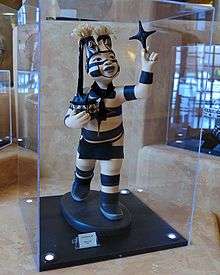Pueblo clown

The Pueblo clowns (sometimes called sacred clowns) are jesters or tricksters in the Kachina religion (practiced by the Pueblo Indians of the southwestern United States). It is a generic term, as there are a number of these figures in the ritual practice of the Pueblo people. Each has a unique role; belonging to separate Kivas (secret societies or confraternities) and each has a name that differs from one mesa or pueblo to another.
Roles
The clowns perform during the spring and summer fertility rites. Among the Hopi there are five figures who serve as clowns: the Payakyamu; the Koshare (or Koyaala or Hano clown); the Tsuku; the Tatsiqto (or Koyemsi or Mudhead); and the Kwikwilyak.[1] With the exception of the Koshare, each is a kachinam (personification of a spirit). It is believed that when a member of a kiva dons the mask of a kachinam, he abandons his personality and becomes possessed by that spirit.
In order for a clown to perform meaningful social commentary via humor, the clown's identity must usually be concealed. The sacred clowns of the Pueblo people, however, do not employ masks but rely on body paint and head dresses. Among the best known orders of the sacred Pueblo clown is the Chiffoneti (called Paiakyamu in Hopi, Kossa in the Tewa language, Koshare among the Keres people, Tabösh at Jemez, New Mexico, and Newekwe by the Zuñi). These individuals present themselves with black and white horizontal stripes painted on their bodies and faces, paint black circles around the mouth and eyes, and part their hair in the center and bind it in two bunches which stand upright on each side of the head and are trimmed with corn husks.[2]
The mudheads (called Koyemshi in Zuni, and Tachuki in Hopi) are usually portrayed by pinkish clay coated bodies and matching cotton bag worn over the head.[3]
Anthropologists, most notably Adolf Bandelier in his 1890 book, The Delight Makers, and Elsie Clews Parsons in her Pueblo Indian Religion, have extensively studied the meaning of the Pueblo clowns and clown society in general. Bandelier notes that the Tsuku were somewhat feared by the Hopi as the source of public criticism and censure of non-Hopi like behavior. Their function can help defuse community tensions by providing their own humorous interpretation of the tribe's popular culture, by re-enforcing taboos, and by communicating traditions.
See also
Notes
- ↑ Pecina, 2013
- ↑ Londré, Felicia Hardison (1998). The history of North American theater : the United States, Canada, and Mexico : from pre-Columbian times to the present. New York: Continuum. ISBN 9780826410795.
- ↑ Roediger, Virginia More (1991). Ceremonial Costumes of the Pueblo Indians: Their Evolution, Fabrication, and Significance in the Prayer Drama. Berkeley: University of California Press. p. 229.
References
- Gutenberg etext of Adolf Bandelier The Delight Makers
- P. Farb, Man's Rise to Civilisation, 1971.
- M. Conrad Hyers The Spirituality of Comedy: comic heroism in a tragic world 1996 Transaction Publishers ISBN 1-56000-218-2
- Elsie Clews Parsons Pueblo Indian Religion, University of Chicago Press, 1939.
- Elsie Clews Parsons and Ralph L. Beals, The Sacred Clowns of the Pueblo and Mayo-Yaqui Indians American Anthropologist, New Series, Vol. 36, No. 4 (October–December, 1934), pp. 491–514
- Pecina, Ron and Pecina, Bob. Hopi Kachinas: History, Legends, and Art. Schiffer Publishing Ltd. 2013; ISBN 978-0-7643-4429-9. Pages 124-138.
- J. H. Steward, The Ceremonial Buffoons of the American Indians, Michigan Academy of Sciences, pp 187–207, 1930.